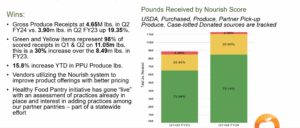The head of the FDA put the transformative impact of good nutrition into perspective when he said in a March 2018 speech that the public health gains of improved diet “would almost certainly dwarf any single medical innovation or intervention we could discover.”
Who knew that one of the most powerful avenues to elevating the entire nation’s health was as simple as good food?
Dr. Scott Gottlieb’s bold statement, put forth at the National Food Policy Conference in D.C., came about a year and a half after the American Academy of Pediatrics struck a similar tone, by issuing a policy statement urging pediatricians to screen their patients for food insecurity, since such kids are “likely to be sick more often, recover from illness more slowly, and be hospitalized more frequently.”
The idea that a lack of access to adequate and nutritious food could have a big impact on a person’s health makes intuitive sense, but only in recent years has the concept taken hold strongly enough to influence policy. Congress caught on in January 2018, forming a bipartisan working group called Food is Medicine, to emphasize the link between food and health, and create policies aimed at supporting healthy outcomes through access to good nutrition.
Adding further momentum to the good-food movement is emerging data about the healthcare costs of poor nutrition. Food-insecure households spend roughly 45% more on medical costs than households that have enough food, highlighted the Center on Budget & Policy Priorities in a January 2018 report. Bread for the World conservatively estimated in November 2015 that hunger and food insecurity add at least $160 billion to national healthcare spending. That’s about $60 billion more than the country spends on federal nutrition programs.
As a vital link between food-insecure individuals and the food they eat, there’s no way around the fact that food banks can play a crucial role in advancing the overall health of the country. Increasingly, food banks are stepping up to the challenge, distributing greater quantities of fresh and healthy food, and building relationships with healthcare providers to help promote the virtues of good nutrition. The Greater Boston Food Bank and San Francisco Marin Food Bank are just two examples of organizations that are breaking new ground in this area.
Connect with Us:





